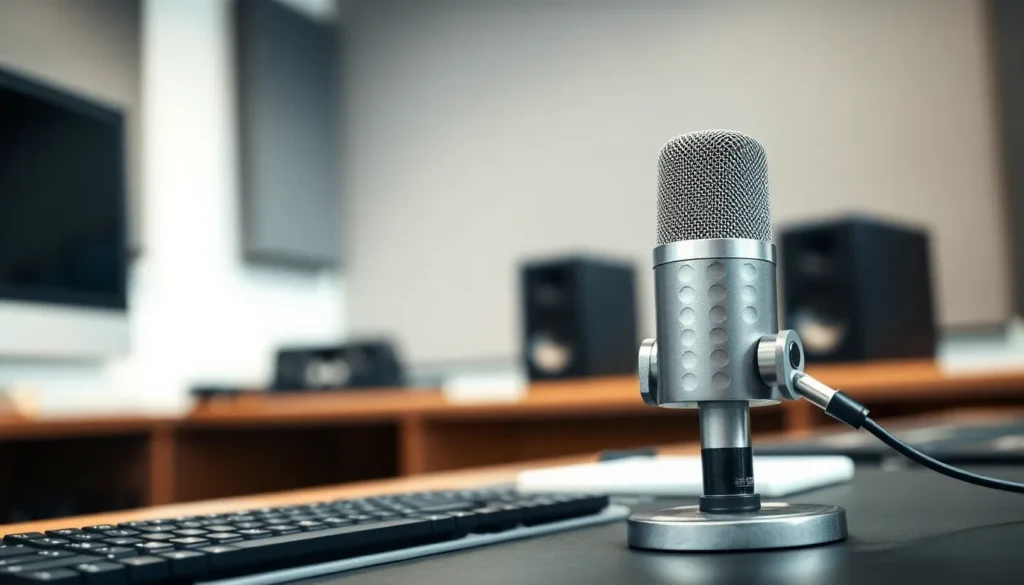In a world where everyone’s a potential podcaster or YouTube star, the right USB microphone can be a game-changer. Gone are the days of sounding like you’re recording from a potato. With a USB mic, clarity and professionalism are just a plug away. It’s like upgrading from a flip phone to the latest smartphone—suddenly, you’re in the big leagues.
Whether he’s streaming his gaming adventures or she’s recording her latest musical masterpiece, a quality USB microphone delivers crisp sound that makes listeners lean in. Plus, it’s as easy to use as a slice of pizza on a Friday night—just plug it in, and you’re ready to roll. So why settle for mediocre audio when you can sound like a pro? Let’s dive into the world of USB microphones and discover how they can elevate any audio project to new heights.
Table of Contents
ToggleOverview of USB Microphones
USB microphones serve as a vital tool for various audio applications, including podcasting, gaming, and music production. These microphones connect directly to computers or devices via USB, simplifying the recording process. Plug-and-play functionality allows users to start recording without complicated setups, making them ideal for beginners and professionals alike.
Audio clarity remains a primary advantage of USB microphones. Compared to built-in computer microphones, USB models capture sound with greater fidelity and detail. This enhancement transforms projects, elevating the overall quality of recordings. Various models offer different features, such as directional pickup patterns, which isolate sound sources and reduce background noise.
Portability adds to the appeal of USB microphones. Many lightweight options enable easy transport, making them convenient for on-the-go content creation. Users can take their microphones to different locations, ensuring consistent audio quality in varied environments.
Affordability makes USB microphones accessible to a wide audience. Numerous budget-friendly options exist, offering decent sound quality without breaking the bank. Even high-end models remain relatively affordable compared to traditional studio microphones, appealing to budget-conscious content creators.
Additionally, diverse options cater to individual preferences and needs. Some USB microphones are designed for specific uses, such as streaming, while others excel in studio recording settings. The variety available allows users to select a microphone that best suits their audio requirements.
Overall, USB microphones combine quality, convenience, and affordability, making them an excellent choice for anyone looking to improve their audio experience.
Benefits of Using USB Microphones
USB microphones offer numerous advantages that enhance audio quality for various applications like podcasting, gaming, and music recording.
Convenience and Portability
USB microphones boast convenience, as many devices easily connect via USB, leading to quick setup. Lightweight designs promote portability, allowing users to transport their microphones effortlessly. Streamlining the process, these mics enable recording in various environments without sacrificing audio quality. Users appreciate plug-and-play functionality, which eliminates the need for complicated installations. Many professionals and beginners enjoy the flexibility and comfort that these microphones provide. Overall, the design allows creators to adapt their recording setups quickly.
Compatibility with Devices
Compatibility with devices is another significant advantage of USB microphones. These microphones seamlessly connect to computers, laptops, and some tablets, making them versatile. Most operating systems, including Windows and macOS, recognize USB microphones with ease. This broad compatibility ensures that users can make recordings without worrying about software issues. Many USB microphones also work with various recording software, enhancing the user experience. As a result, audio creators can enjoy a consistent and reliable performance across multiple platforms.
Key Features to Consider
When selecting a USB microphone, several key features significantly impact audio performance and user experience. Understanding these aspects helps in making an informed decision.
Sound Quality
Sound quality ranks as one of the most important features. High-fidelity microphones capture voices and instruments with clarity. A frequency response range between 20 Hz and 20 kHz often delivers optimal sound reproduction. Additional nuance from condenser microphones enhances vocal presence, making them ideal for podcasts and music. Noise cancellation technology can further refine recordings by minimizing background sounds. Users often notice that USB microphones with higher sensitivity (around -40 dB) offer better performance in various environments.
Build Quality
Build quality plays a crucial role in durability and reliability. Microphones constructed from robust materials withstand regular use in diverse settings. Many models feature metal housings, which provide added protection against damage. Weight can also indicate sturdiness; heavier microphones often utilize higher quality components. A shock mount is an essential addition that enhances stability while recording. Portability should not compromise build quality, as lightweight, durable materials still offer excellent performance.
Additional Functionalities
Additional functionalities can elevate the user experience. Some USB microphones include built-in audio interfaces for easy adjustments. Features like mute buttons and headphone outputs enhance convenience during recordings. Compatibility with various software increases versatility, allowing for integration into different workflows. USB Type-C connections often provide faster data transfer, improving overall performance. Many users appreciate customizable settings, which often allow adjustments for specific applications, catering to individual preferences.
Top USB Microphone Recommendations
USB microphones offer a range of options suitable for various budgets and professional needs. Selecting the right one significantly enhances audio quality and recording experiences.
Budget Options
Affordable USB microphones provide excellent sound quality without considerable expense. The Fifine K669B stands out for its clear audio capture and sleek design, making it ideal for beginners. Blue Snowball iCE also offers versatility, catering perfectly to podcasters and gamers alike. Both mics deliver impressive performance while remaining budget-friendly. The Samson Q2U features USB and XLR outputs, providing flexibility for future upgrades. Each of these options proves that good sound quality doesn’t require breaking the bank.
Professional Choices
For higher-end requirements, certain USB microphones rise above the rest. The Audio-Technica AT2020USB+ excels with its studio-quality sound and built-in headphone jack for real-time monitoring. Users will appreciate the robust build quality and the detailed audio reproduction. Another standout is the Rode NT-USB, featuring a pop filter and onboard controls, enhancing its functionality for serious creators. The Shure MV7, designed for both USB and XLR connections, delivers broadcast-quality sound and is particularly favored by podcasters. These professional choices guarantee superior audio fidelity and expand creative possibilities.
Investing in a quality USB microphone can elevate any audio project. With their ease of use and superior sound clarity, they cater to a wide range of users from beginners to seasoned professionals. The portability and affordability of these microphones make them a practical choice for anyone looking to enhance their recordings.
Whether it’s for podcasting, gaming, or music production, USB microphones provide the necessary tools to achieve professional-grade audio. With various options available, users can find a model that fits their needs and budget, ensuring that high-quality sound is within reach for all. Embracing the right USB microphone can make a significant difference in audio quality and overall production value.









